warning MITSUBISHI OUTLANDER PHEV 2016 Owner's Manual (in English)
[x] Cancel search | Manufacturer: MITSUBISHI, Model Year: 2016, Model line: OUTLANDER PHEV, Model: MITSUBISHI OUTLANDER PHEV 2016Pages: 490, PDF Size: 22.02 MB
Page 2 of 490
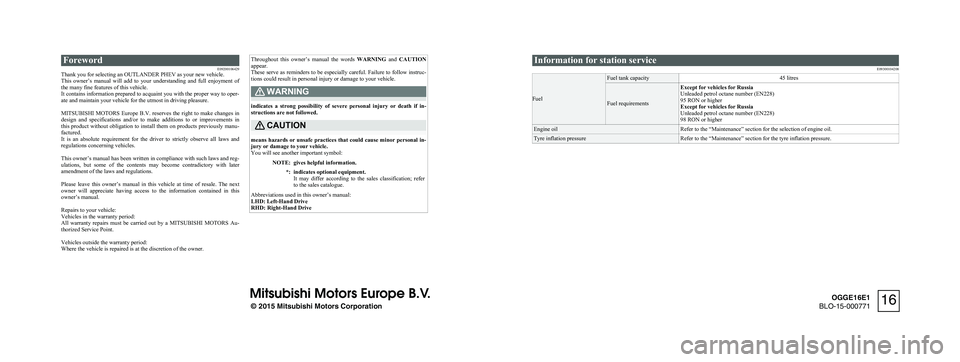
ForewordE09200106429
Thank you for selecting an OUTLANDER PHEV as your new vehicle.
This owner’s manual will add to your understanding and full enjoyment of
the many fine features of this vehicle.
It contains information prepared to acquaint you with the proper way to oper-
ate and maintain your vehicle for the utmost in driving pleasure.
MITSUBISHI MOTORS Europe B.V. reserves the right to make changes in
design and specifications and/or to make additions to or improvements in
this product without obligation to install them on products previously manu- factured.
It is an absolute requirement for the driver to strictly observe all laws and
regulations concerning vehicles.
This owner’s manual has been written in compliance with such laws and reg- ulations, but some of the contents may become contradictory with later amendment of the laws and regulations.
Please leave this owner’s manual in this vehicle at time of resale. The next
owner will appreciate having access to the information contained in this
owner’s manual.
Repairs to your vehicle:
Vehicles in the warranty period:
All warranty repairs must be carried out by a MITSUBISHI MOTORS Au-
thorized Service Point.
Vehicles outside the warranty period:
Where the vehicle is repaired is at the discretion of the owner.
Throughout this owner’s manual the words WARNING and CAUTION
appear.
These serve as reminders to be especially careful. Failure to follow instruc-
tions could result in personal injury or damage to your vehicle.WARNING
indicates a strong possibility of severe personal injury or death if in- structions are not followed.
CAUTION
means hazards or unsafe practices that could cause minor personal in-
jury or damage to your vehicle.
You will see another important symbol:
NOTE:gives helpful information.*:indicates optional equipment.
It may differ according to the sales classification; refer to the sales catalogue.
Abbreviations used in this owner’s manual:
LHD: Left-Hand Drive
RHD: Right-Hand Drive
Information for station service
E09300104208
Fuel
Fuel tank capacity45 litres
Fuel requirements
Except for vehicles for Russia
Unleaded petrol octane number (EN228)
95 RON or higher
Except for vehicles for Russia
Unleaded petrol octane number (EN228)
98 RON or higherEngine oilRefer to the “Maintenance” section for the selection of engine oil.Tyre inflation pressureRefer to the “Maintenance” section for the tyre inflation pressure.
© 2015 Mitsubishi Motors Corporation
16
OGGE16E1
BLO-15-000771
Page 4 of 490
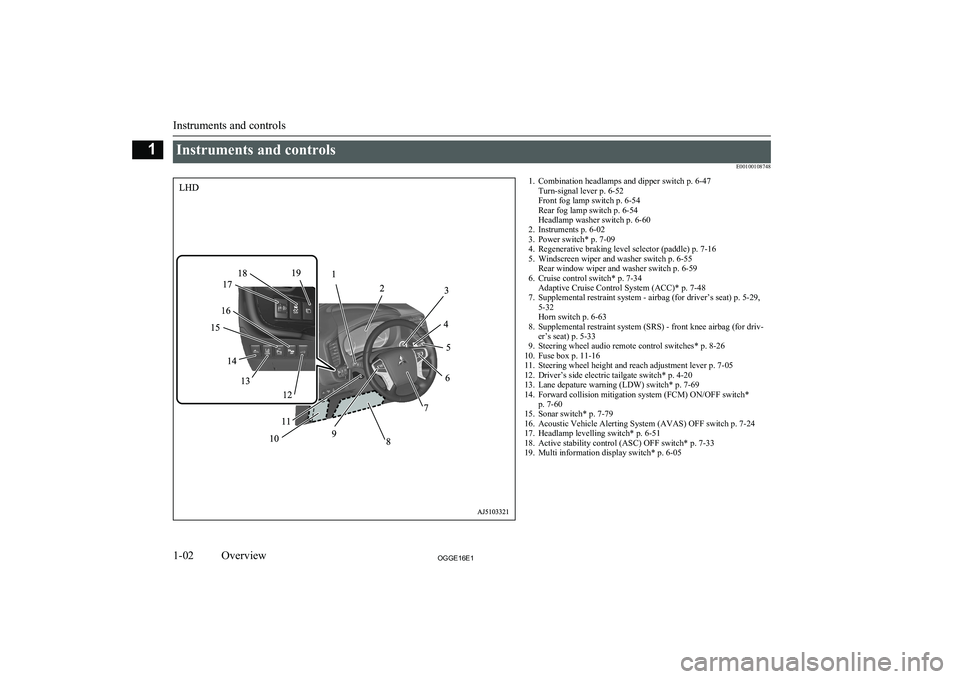
Instruments and controlsE001001087481. Combination headlamps and dipper switch p. 6-47Turn-signal lever p. 6-52
Front fog lamp switch p. 6-54
Rear fog lamp switch p. 6-54
Headlamp washer switch p. 6-60
2. Instruments p. 6-02
3. Power switch* p. 7-09
4. Regenerative braking level selector (paddle) p. 7-16
5. Windscreen wiper and washer switch p. 6-55 Rear window wiper and washer switch p. 6-59
6. Cruise control switch* p. 7-34 Adaptive Cruise Control System (ACC)* p. 7-48
7. Supplemental restraint system - airbag (for driver’s seat) p. 5-29, 5-32
Horn switch p. 6-63
8. Supplemental restraint system (SRS) - front knee airbag (for driv- er’s seat) p. 5-33
9. Steering wheel audio remote control switches* p. 8-26
10. Fuse box p. 11-16
11. Steering wheel height and reach adjustment lever p. 7-05
12. Driver’s side electric tailgate switch* p. 4-20
13. Lane depature warning (LDW) switch* p. 7-69
14. Forward collision mitigation system (FCM) ON/OFF switch* p. 7-60
15. Sonar switch* p. 7-79
16. Acoustic Vehicle Alerting System (AVAS) OFF switch p. 7-24
17. Headlamp levelling switch* p. 6-51
18. Active stability control (ASC) OFF switch* p. 7-33
19. Multi information display switch* p. 6-05
Instruments and controls
1-02OGGE16E1Overview1
Page 5 of 490
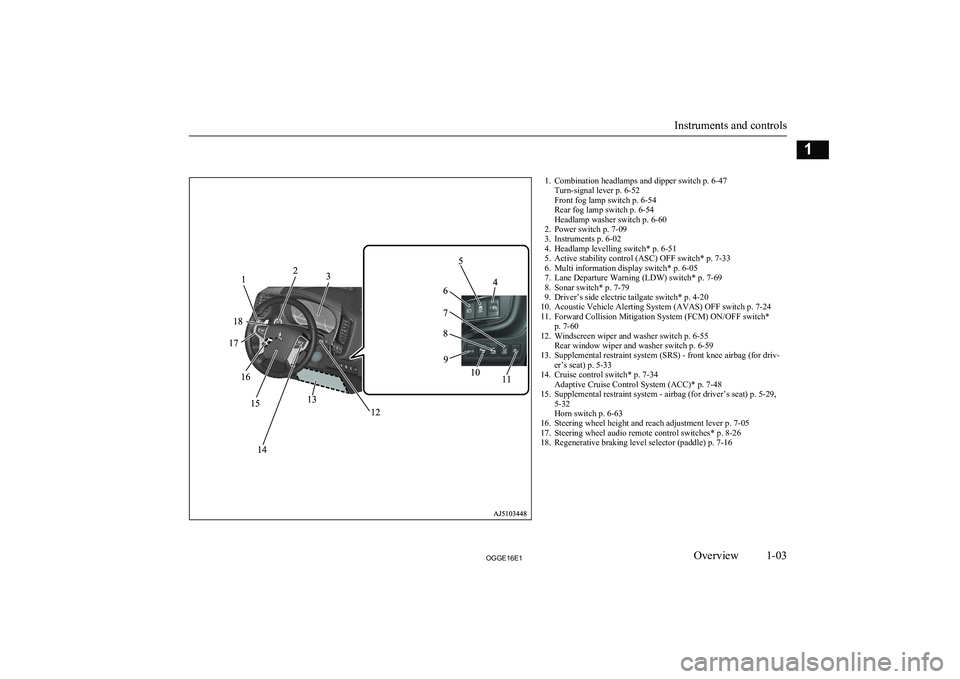
1. Combination headlamps and dipper switch p. 6-47Turn-signal lever p. 6-52
Front fog lamp switch p. 6-54
Rear fog lamp switch p. 6-54
Headlamp washer switch p. 6-60
2. Power switch p. 7-09
3. Instruments p. 6-02
4. Headlamp levelling switch* p. 6-51
5. Active stability control (ASC) OFF switch* p. 7-33
6. Multi information display switch* p. 6-05
7. Lane Departure Warning (LDW) switch* p. 7-69
8. Sonar switch* p. 7-79
9. Driver’s side electric tailgate switch* p. 4-20
10. Acoustic Vehicle Alerting System (AVAS) OFF switch p. 7-24
11. Forward Collision Mitigation System (FCM) ON/OFF switch* p. 7-60
12. Windscreen wiper and washer switch p. 6-55 Rear window wiper and washer switch p. 6-59
13. Supplemental restraint system (SRS) - front knee airbag (for driv- er’s seat) p. 5-33
14. Cruise control switch* p. 7-34 Adaptive Cruise Control System (ACC)* p. 7-48
15. Supplemental restraint system - airbag (for driver’s seat) p. 5-29, 5-32
Horn switch p. 6-63
16. Steering wheel height and reach adjustment lever p. 7-05
17. Steering wheel audio remote control switches* p. 8-26
18. Regenerative braking level selector (paddle) p. 7-16
Instruments and controls
1-03OGGE16E1Overview1
Page 6 of 490
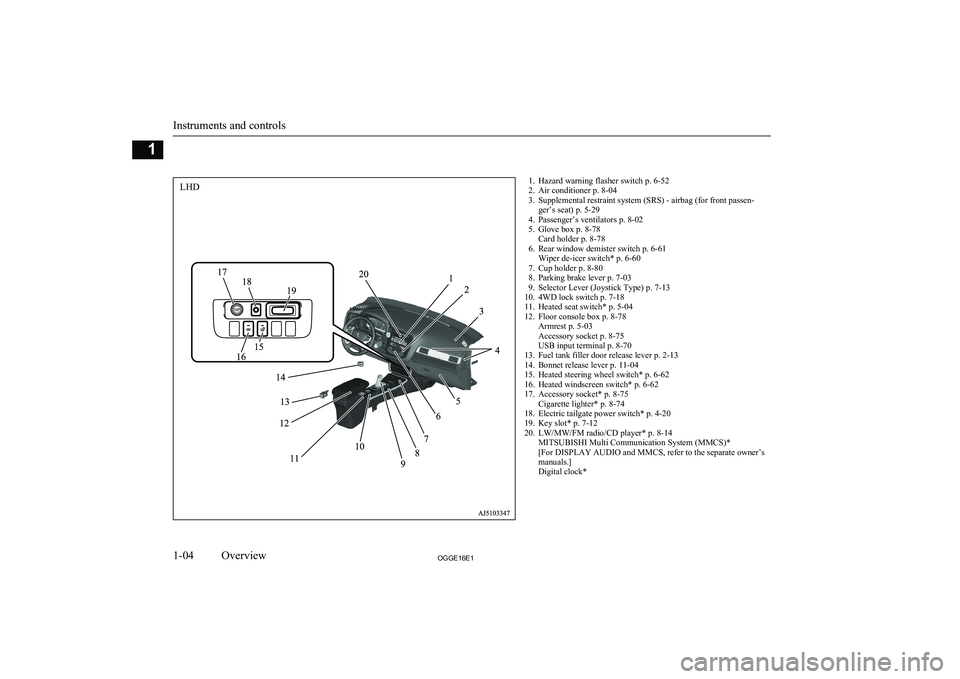
1. Hazard warning flasher switch p. 6-52
2. Air conditioner p. 8-04
3. Supplemental restraint system (SRS) - airbag (for front passen- ger’s seat) p. 5-29
4. Passenger’s ventilators p. 8-02
5. Glove box p. 8-78 Card holder p. 8-78
6. Rear window demister switch p. 6-61 Wiper de-icer switch* p. 6-60
7. Cup holder p. 8-80
8. Parking brake lever p. 7-03
9. Selector Lever (Joystick Type) p. 7-13
10. 4WD lock switch p. 7-18
11. Heated seat switch* p. 5-04
12. Floor console box p. 8-78 Armrest p. 5-03
Accessory socket p. 8-75
USB input terminal p. 8-70
13. Fuel tank filler door release lever p. 2-13
14. Bonnet release lever p. 11-04
15. Heated steering wheel switch* p. 6-62
16. Heated windscreen switch* p. 6-62
17. Accessory socket* p. 8-75 Cigarette lighter* p. 8-74
18. Electric tailgate power switch* p. 4-20
19. Key slot* p. 7-12
20. LW/MW/FM radio/CD player* p. 8-14 MITSUBISHI Multi Communication System (MMCS)*
[For DISPLAY AUDIO and MMCS, refer to the separate owner’s
manuals.]
Digital clock*
Instruments and controls
1-04OGGE16E1Overview1LHD
Page 7 of 490
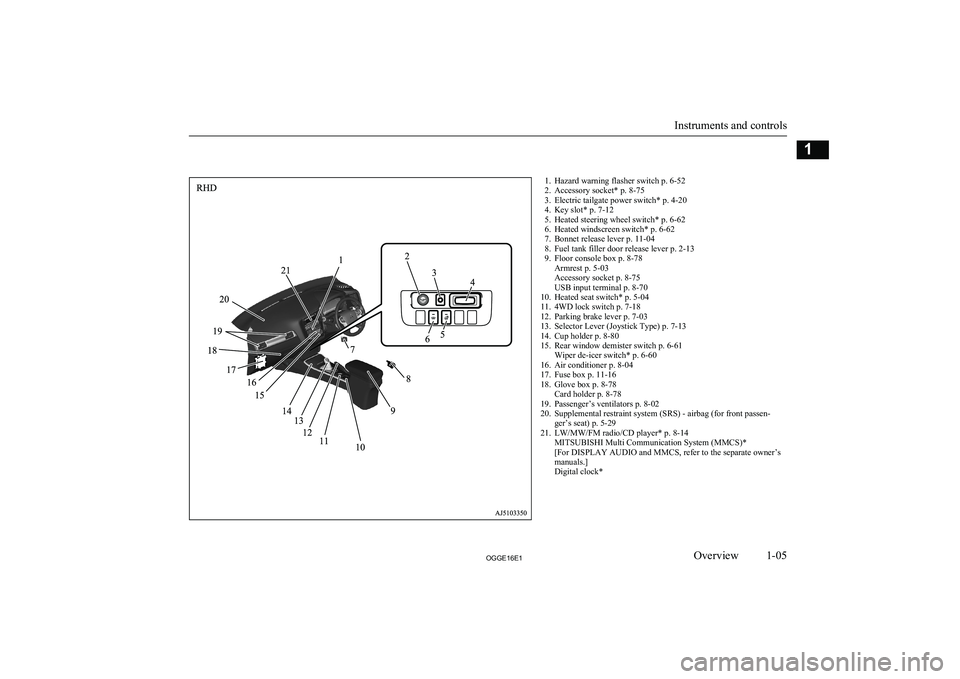
1. Hazard warning flasher switch p. 6-52
2. Accessory socket* p. 8-75
3. Electric tailgate power switch* p. 4-20
4. Key slot* p. 7-12
5. Heated steering wheel switch* p. 6-62
6. Heated windscreen switch* p. 6-62
7. Bonnet release lever p. 11-04
8. Fuel tank filler door release lever p. 2-13
9. Floor console box p. 8-78 Armrest p. 5-03
Accessory socket p. 8-75
USB input terminal p. 8-70
10. Heated seat switch* p. 5-04
11. 4WD lock switch p. 7-18
12. Parking brake lever p. 7-03
13. Selector Lever (Joystick Type) p. 7-13
14. Cup holder p. 8-80
15. Rear window demister switch p. 6-61 Wiper de-icer switch* p. 6-60
16. Air conditioner p. 8-04
17. Fuse box p. 11-16
18. Glove box p. 8-78 Card holder p. 8-78
19. Passenger’s ventilators p. 8-02
20. Supplemental restraint system (SRS) - airbag (for front passen- ger’s seat) p. 5-29
21. LW/MW/FM radio/CD player* p. 8-14 MITSUBISHI Multi Communication System (MMCS)*
[For DISPLAY AUDIO and MMCS, refer to the separate owner’s
manuals.]
Digital clock*
Instruments and controls
1-05OGGE16E1Overview1
Page 17 of 490
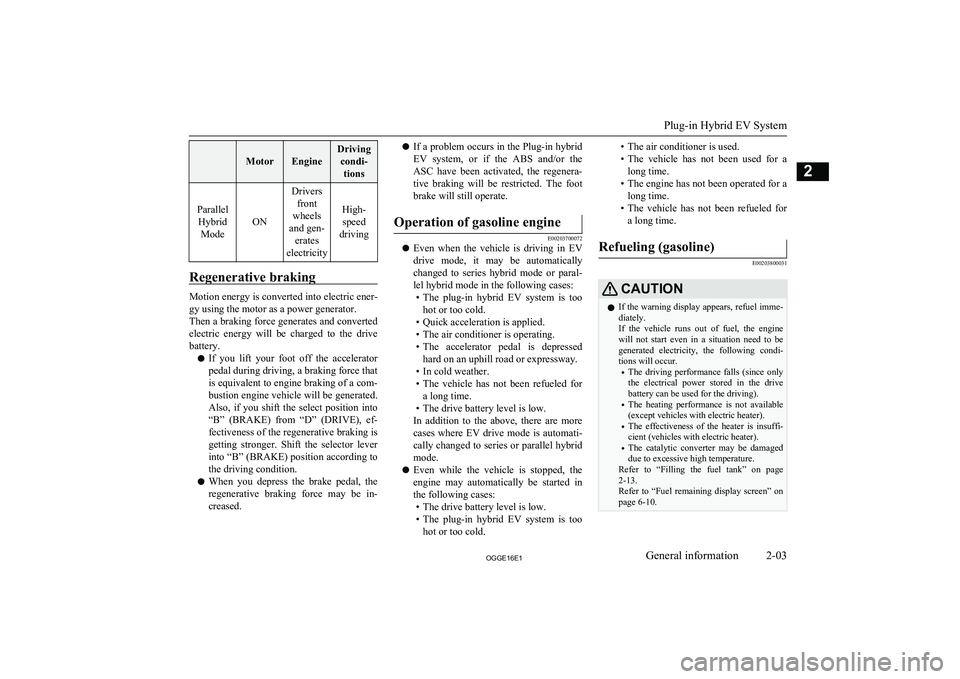
MotorEngine
Drivingcondi- tions
ParallelHybrid Mode
ON
Drivers front
wheels
and gen- erates
electricity
High- speed
driving
Regenerative braking
Motion energy is converted into electric ener-
gy using the motor as a power generator.
Then a braking force generates and converted electric energy will be charged to the drive
battery.
l If you lift your foot off the accelerator
pedal during driving, a braking force that
is equivalent to engine braking of a com- bustion engine vehicle will be generated.
Also, if you shift the select position into “B” (BRAKE) from “D” (DRIVE), ef-
fectiveness of the regenerative braking is getting stronger. Shift the selector lever into “B” (BRAKE) position according to
the driving condition.
l When you depress the brake pedal, the
regenerative braking force may be in-creased.
l If a problem occurs in the Plug-in hybrid
EV system, or if the ABS and/or the
ASC have been activated, the regenera- tive braking will be restricted. The foot brake will still operate.Operation of gasoline engine
E00203700072
l Even when the vehicle is driving in EV
drive mode, it may be automatically
changed to series hybrid mode or paral-
lel hybrid mode in the following cases: • The plug-in hybrid EV system is too
hot or too cold.
• Quick acceleration is applied.
• The air conditioner is operating.
• The accelerator pedal is depressed
hard on an uphill road or expressway.
• In cold weather.
• The vehicle has not been refueled for
a long time.
• The drive battery level is low.
In addition to the above, there are more
cases where EV drive mode is automati-
cally changed to series or parallel hybrid mode.
l Even while the vehicle is stopped, the
engine may automatically be started in the following cases: • The drive battery level is low.
• The plug-in hybrid EV system is too
hot or too cold.
• The air conditioner is used.
• The vehicle has not been used for a
long time.
• The engine has not been operated for a long time.
• The vehicle has not been refueled for
a long time.Refueling (gasoline)
E00203800031
CAUTIONl If the warning display appears, refuel imme-
diately.
If the vehicle runs out of fuel, the engine will not start even in a situation need to be
generated electricity, the following condi- tions will occur.
• The driving performance falls (since only
the electrical power stored in the drive battery can be used for the driving).
• The heating performance is not available
(except vehicles with electric heater).
• The effectiveness of the heater is insuffi-
cient (vehicles with electric heater).
• The catalytic converter may be damaged
due to excessive high temperature.
Refer to “Filling the fuel tank” on page 2-13.
Refer to “Fuel remaining display screen” on page 6-10.
Plug-in Hybrid EV System
2-03OGGE16E1General information2
Page 18 of 490
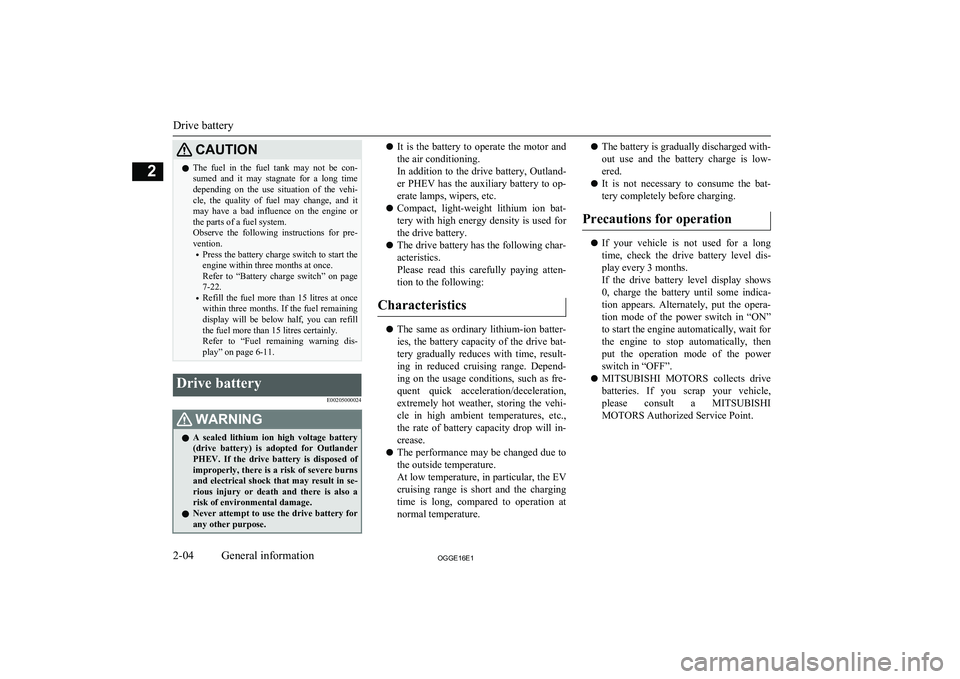
CAUTIONlThe fuel in the fuel tank may not be con-
sumed and it may stagnate for a long time
depending on the use situation of the vehi- cle, the quality of fuel may change, and it
may have a bad influence on the engine or the parts of a fuel system.
Observe the following instructions for pre-
vention.
• Press the battery charge switch to start the
engine within three months at once.Refer to “Battery charge switch” on page
7-22.
• Refill the fuel more than 15 litres at once
within three months. If the fuel remaining display will be below half, you can refillthe fuel more than 15 litres certainly.Refer to “Fuel remaining warning dis-
play” on page 6-11.Drive battery
E00205000024WARNINGlA sealed lithium ion high voltage battery
(drive battery) is adopted for OutlanderPHEV . If the drive battery is disposed of
improperly, there is a risk of severe burns
and electrical shock that may result in se-
rious injury or death and there is also a
risk of environmental damage.
l Never attempt to use the drive battery for
any other purpose.l It is the battery to operate the motor and
the air conditioning.
In addition to the drive battery, Outland-
er PHEV has the auxiliary battery to op-
erate lamps, wipers, etc.
l Compact, light-weight lithium ion bat-
tery with high energy density is used forthe drive battery.
l The drive battery has the following char-
acteristics.
Please read this carefully paying atten- tion to the following:
Characteristics
l The same as ordinary lithium-ion batter-
ies, the battery capacity of the drive bat-
tery gradually reduces with time, result- ing in reduced cruising range. Depend-
ing on the usage conditions, such as fre- quent quick acceleration/deceleration, extremely hot weather, storing the vehi-
cle in high ambient temperatures, etc.,
the rate of battery capacity drop will in- crease.
l The performance may be changed due to
the outside temperature.
At low temperature, in particular, the EV
cruising range is short and the charging time is long, compared to operation at
normal temperature.
l The battery is gradually discharged with-
out use and the battery charge is low- ered.
l It is not necessary to consume the bat-
tery completely before charging.
Precautions for operation
l If your vehicle is not used for a long
time, check the drive battery level dis-
play every 3 months.
If the drive battery level display shows
0, charge the battery until some indica- tion appears. Alternately, put the opera-
tion mode of the power switch in “ON” to start the engine automatically, wait for
the engine to stop automatically, then
put the operation mode of the power switch in “OFF”.
l MITSUBISHI
MOTORS collects drive
batteries. If you scrap your vehicle, please consult a MITSUBISHI
MOTORS Authorized Service Point.
Drive battery
2-04OGGE16E1General information2
Page 19 of 490
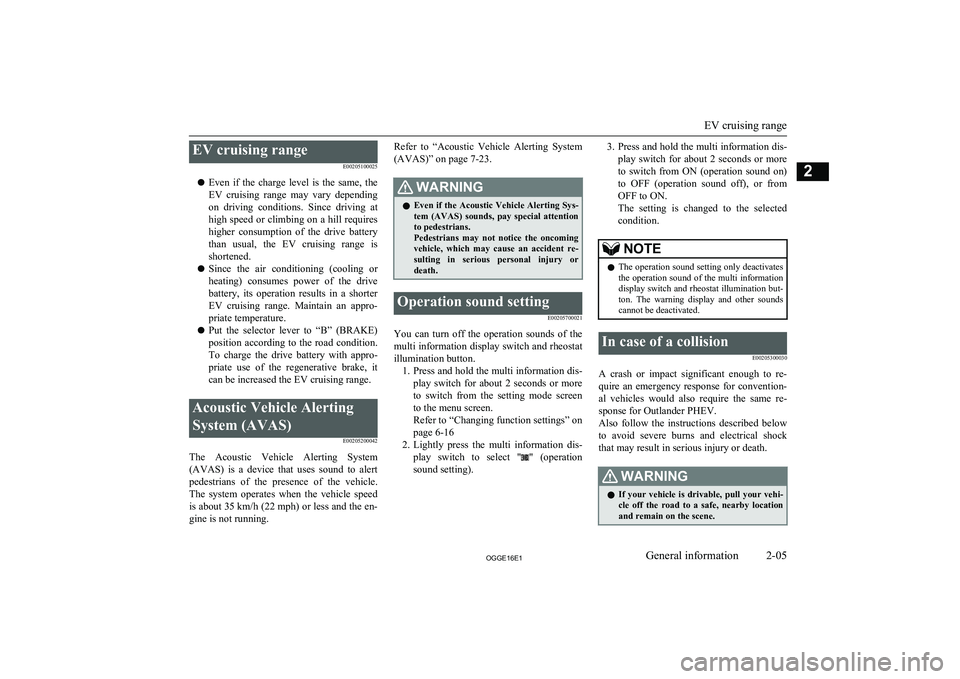
EV cruising rangeE00205100025
l Even if the charge level is the same, the
EV cruising range may vary depending on driving conditions. Since driving at
high speed or climbing on a hill requires higher consumption of the drive batterythan usual, the EV cruising range is shortened.
l Since the air conditioning (cooling or
heating) consumes power of the drive
battery, its operation results in a shorter EV cruising range. Maintain an appro- priate temperature.
l Put the selector lever to “B” (BRAKE)
position according to the road condition. To charge the drive battery with appro-priate use of the regenerative brake, it
can be increased the EV cruising range.Acoustic Vehicle Alerting
System (AVAS) E00205200042
The Acoustic Vehicle Alerting System(AVAS) is a device that uses sound to alert
pedestrians of the presence of the vehicle. The system operates when the vehicle speed
is about 35 km/h (22 mph) or less and the en-
gine is not running.
Refer to “Acoustic Vehicle Alerting System
(AVAS)” on page 7-23.WARNINGl Even if the Acoustic Vehicle Alerting Sys-
tem (AVAS) sounds, pay special attention
to pedestrians.
Pedestrians may not notice the oncoming vehicle, which may cause an accident re-
sulting in serious personal injury or death.Operation sound setting
E00205700021
You can turn off the operation sounds of the
multi information display switch and rheostat illumination button. 1. Press and hold the multi information dis-
play switch for about 2 seconds or more to switch from the setting mode screen
to the menu screen.
Refer to “Changing function settings” on
page 6-16
2. Lightly press the multi information dis-
play switch to select "
" (operation
sound setting).
3. Press and hold the multi information dis-
play switch for about 2 seconds or moreto switch from ON (operation sound on)
to OFF (operation sound off), or from OFF to ON.
The setting is changed to the selected
condition.NOTEl The operation sound setting only deactivates
the operation sound of the multi information
display switch and rheostat illumination but- ton. The warning display and other soundscannot be deactivated.In case of a collision
E00205300030
A crash or impact significant enough to re-
quire an emergency response for convention- al vehicles would also require the same re-sponse for Outlander PHEV.
Also follow the instructions described below to avoid severe burns and electrical shock
that may result in serious injury or death.
WARNINGl If your vehicle is drivable, pull your vehi-
cle off the road to a safe, nearby location
and remain on the scene.
EV cruising range
2-05OGGE16E1General information2
Page 20 of 490
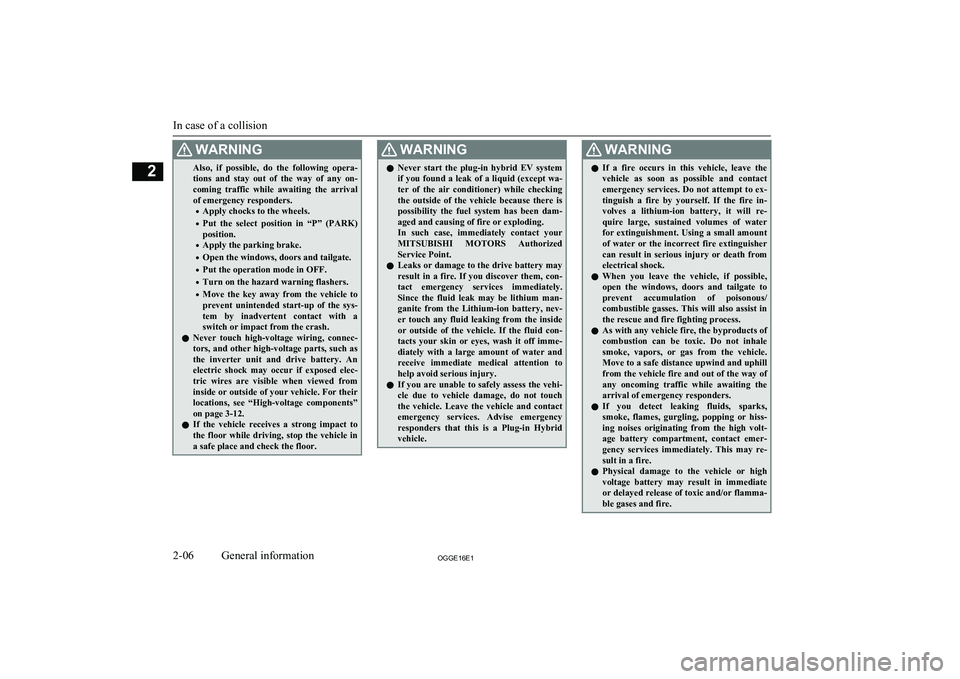
WARNINGAlso, if possible, do the following opera-
tions and stay out of the way of any on-
coming traffic while awaiting the arrival of emergency responders.
• Apply chocks to the wheels.
• Put the select position in “P” (PARK)
position.
• Apply the parking brake.
• Open the windows, doors and tailgate.
• Put the operation mode in OFF.
• Turn on the hazard warning flashers.
• Move the key away from the vehicle to
prevent unintended start-up of the sys- tem by inadvertent contact with a switch or impact from the crash.
l Never touch high-voltage wiring, connec-
tors, and other high-voltage parts, such as
the inverter unit and drive battery. An electric shock may occur if exposed elec-
tric wires are visible when viewed from inside or outside of your vehicle. For their locations, see “High-voltage components”
on page 3-12.
l If the vehicle receives a strong impact to
the floor while driving, stop the vehicle in
a safe place and check the floor.WARNINGl Never start the plug-in hybrid EV system
if you found a leak of a liquid (except wa-
ter of the air conditioner) while checking the outside of the vehicle because there is
possibility the fuel system has been dam- aged and causing of fire or exploding.
In such case, immediately contact your
MITSUBISHI MOTORS Authorized
Service Point.
l Leaks or damage to the drive battery may
result in a fire. If you discover them, con-
tact emergency services immediately.
Since the fluid leak may be lithium man- ganite from the Lithium-ion battery, nev- er touch any fluid leaking from the inside
or outside of the vehicle. If the fluid con- tacts your skin or eyes, wash it off imme-
diately with a large amount of water and receive immediate medical attention to
help avoid serious injury.
l If you are unable to safely assess the vehi-
cle due to vehicle damage, do not touch the vehicle. Leave the vehicle and contact
emergency services. Advise emergency responders that this is a Plug-in Hybrid
vehicle.WARNINGl If a fire occurs in this vehicle, leave the
vehicle as soon as possible and contact
emergency services. Do not attempt to ex- tinguish a fire by yourself. If the fire in-
volves a lithium-ion battery, it will re- quire large, sustained volumes of water for extinguishment. Using a small amount
of water or the incorrect fire extinguisher
can result in serious injury or death from electrical shock.
l When you leave the vehicle, if possible,
open the windows, doors and tailgate to
prevent accumulation of poisonous/ combustible gasses. This will also assist in
the rescue and fire fighting process.
l As with any vehicle fire, the byproducts of
combustion can be toxic. Do not inhale
smoke, vapors, or gas from the vehicle. Move to a safe distance upwind and uphill
from the vehicle fire and out of the way of any oncoming traffic while awaiting the
arrival of emergency responders.
l If you detect leaking fluids, sparks,
smoke, flames, gurgling, popping or hiss-
ing noises originating from the high volt- age battery compartment, contact emer-
gency services immediately. This may re- sult in a fire.
l Physical damage to the vehicle or high
voltage battery may result in immediate or delayed release of toxic and/or flamma- ble gases and fire.
In case of a collision
2-06OGGE16E1General information2
Page 21 of 490
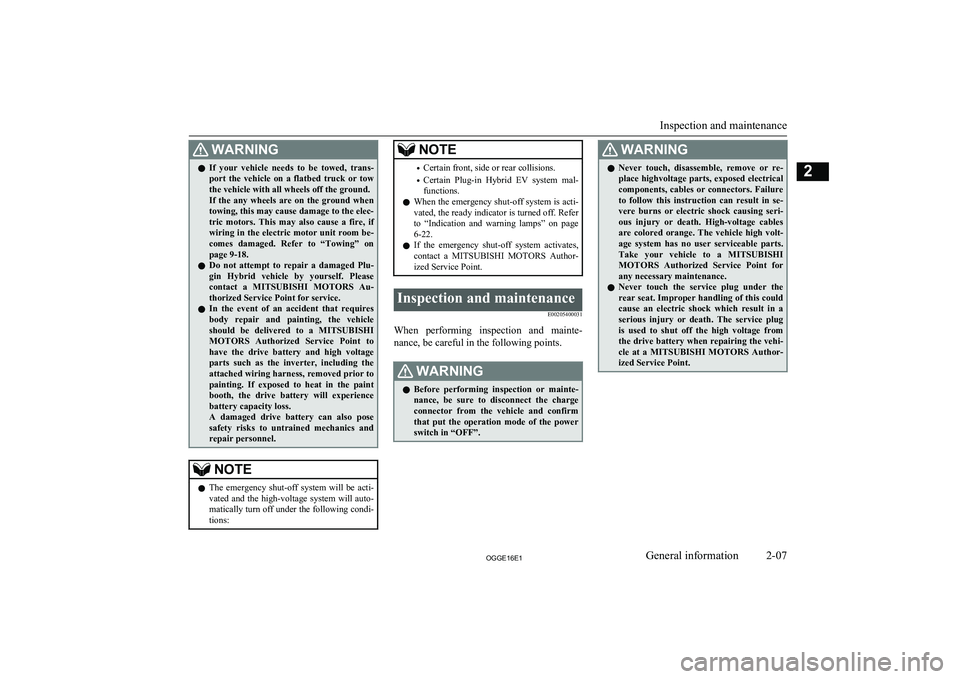
WARNINGlIf your vehicle needs to be towed, trans-
port the vehicle on a flatbed truck or tow
the vehicle with all wheels off the ground.
If the any wheels are on the ground when towing, this may cause damage to the elec-
tric motors. This may also cause a fire, if
wiring in the electric motor unit room be- comes damaged. Refer to “Towing” on
page 9-18.
l Do not attempt to repair a damaged Plu-
gin Hybrid vehicle by yourself. Please contact a MITSUBISHI MOTORS Au-
thorized Service Point for service.
l In the event of an accident that requires
body repair and painting, the vehicle should be delivered to a MITSUBISHI
MOTORS Authorized Service Point to
have the drive battery and high voltage parts such as the inverter, including the
attached wiring harness, removed prior to
painting. If exposed to heat in the paint booth, the drive battery will experiencebattery capacity loss.
A damaged drive battery can also pose
safety risks to untrained mechanics and
repair personnel.NOTEl The emergency shut-off system will be acti-
vated and the high-voltage system will auto- matically turn off under the following condi-
tions:NOTE• Certain front, side or rear collisions.
• Certain Plug-in Hybrid EV system mal-
functions.
l When the emergency shut-off system is acti-
vated, the ready indicator is turned off. Refer to “Indication and warning lamps” on page6-22.
l If the emergency shut-off system activates,
contact a MITSUBISHI MOTORS Author-
ized Service Point.Inspection and maintenance
E00205400031
When performing inspection and mainte-nance, be careful in the following points.
WARNINGl Before performing inspection or mainte-
nance, be sure to disconnect the charge connector from the vehicle and confirmthat put the operation mode of the power
switch in “OFF”.WARNINGl Never touch, disassemble, remove or re-
place highvoltage parts, exposed electrical
components, cables or connectors. Failure
to follow this instruction can result in se- vere burns or electric shock causing seri-ous injury or death. High-voltage cables are colored orange. The vehicle high volt-
age system has no user serviceable parts. Take your vehicle to a MITSUBISHI
MOTORS Authorized Service Point for
any necessary maintenance.
l Never touch the service plug under the
rear seat. Improper handling of this could
cause an electric shock which result in a
serious injury or death. The service plug
is used to shut off the high voltage from the drive battery when repairing the vehi-
cle at a MITSUBISHI MOTORS Author-
ized Service Point.
Inspection and maintenance
2-07OGGE16E1General information2